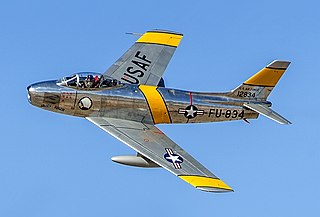
The North American F-86 Sabre, sometimes called the Sabrejet, is a transonic jet fighter aircraft. Produced by North American Aviation, the Sabre is best known as the United States' first swept-wing fighter that could counter the swept-wing Soviet MiG-15 in high-speed dogfights in the skies of the Korean War (1950–1953), fighting some of the earliest jet-to-jet battles in history. Considered one of the best and most important fighter aircraft in that war, the F-86 is also rated highly in comparison with fighters of other eras. Although it was developed in the late 1940s and was outdated by the end of the 1950s, the Sabre proved versatile and adaptable and continued as a front-line fighter in numerous air forces.
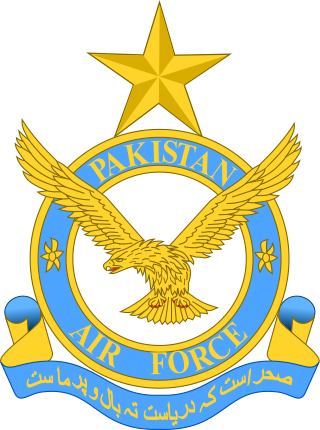
The Pakistan Air Force (PAF) is the aerial warfare branch of the Pakistan Armed Forces, tasked primarily with the aerial defence of Pakistan, with a secondary role of providing air support to the Pakistan Army and Pakistan Navy when required, and a tertiary role of providing strategic airlift capability to Pakistan. As of 2021, as per the International Institute for Strategic Studies, the PAF has more than 70,000 active-duty personnel and operates at least 1370+ aircraft.PAF stands as the eight largest Air Force in the world. PAF is the largest Air Force of the Muslim world in terms of aircraft fleet. Its primary mandate and mission is "to provide, in synergy with other inter-services, the most efficient, assured and cost effective aerial defence of Pakistan." Since its establishment in 1947, the PAF has been involved in various combat operations, providing aerial support to the operations and relief efforts of the Pakistani military. Under Article 243, the Constitution of Pakistan appoints the President of Pakistan as the civilian Commander-in-Chief of the Pakistan Armed Forces. The Chief of the Air Staff (CAS), by statute a four-star air officer, is appointed by the President with the consultation and confirmation needed from the Prime Minister of Pakistan.
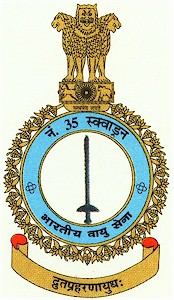
No. 35 Squadron IAF (Rapiers) was an electronic warfare and air superiority squadron of the Indian Air Force (IAF). It was based at Bakshi Ka Talab Airforce Station, No. 35 Squadron came under the Central Air Command; and along with No. 108 Squadron formed an operational wing of the IAF. As of 2017, it was equipped with MiG-21M aircraft. The squadron was number plated in 2019.

Operation Safed Sagar was the code name assigned to the Indian Air Force's role in acting jointly with the Indian Army during the 1999 Kargil war that was aimed at flushing out regular and irregular troops of the Pakistani Army from vacated Indian Positions in the Kargil sector along the Line of Control. It was the first large scale use of Airpower in the Jammu and Kashmir region since the Indo-Pakistani War of 1971.
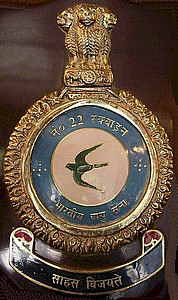
No. 22 Squadron (Swifts) was a CAS unit based out of Hasimara AFS. Along with No. 222 Squadron IAF Tiger Sharks, No. 22 Squadron forms a part of the 16 Wing of the IAF. The squadron operated MiG-27 till December 2017 and the squadron number-plated since then.
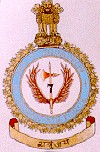
No. 7 Squadron, Indian Air Force operates as a Special Munitions Delivery and air superiority unit. Based at Gwalior AFB, No.7 Squadron forms a part of 40 Wing AF, Central Air Command.

Squadron Leader Sarfaraz Ahmed Rafiqui was a Pakistani fighter pilot who is known for his gallant actions in two of the aerial dogfights during the Indo-Pakistani War of 1965, and is a recipient of both the Hilal-e-Jurat and the Sitara-e-Jurat military awards from the Government of Pakistan.
The No.3 Squadron (Cobras) of the Indian Air Force (IAF) operates as a Close Air Support (CAS) and reconnaissance unit. Currently based at NAL Air Force Station, No. 3 Sqn falls under the Western Air Command, forms the 46 wing of the IAF.
Operation Chengiz Khan was the code name assigned to the preemptive strikes carried out by the Pakistani Air Force (PAF) on the forward airbases and radar installations of the Indian Air Force (IAF) on the evening of 3 December 1971, and marked the formal initiation of hostilities of the Indo-Pakistani War of 1971. The operation targeted 11 of India's airfields and also included artillery strikes on Indian positions in Kashmir. The targets were the Indian Airbases of Amritsar, Ambala, Agra, Awantipur, Bikaner, Halwara, Jodhpur, Jaisalmer, Pathankot, Bhuj, Srinagar and Uttarlai and air defence radars at Amritsar and Faridkot.

During the Indo-Pakistani war of 1965, the Indian and Pakistani Air Forces engaged in large-scale aerial combat for the first time. In the air war, which took place in September, both air forces conducted thousands of defensive and offensive sorties over Indian and Pakistani airspace. Both India and Pakistan claimed victory in the air war; Pakistan claimed to have destroyed 104 Indian aircraft and lost 19, and India claimed to have destroyed 73 Pakistani aircraft and lost 35 of its own. The air war ended in a stalemate.
Wing Commander Trevor Keelor, VrC, VM was an officer of Indian Air Force who participated in the Indo-Pakistani War of 1965. He was honoured with a number of medals including the Vir Chakra and the Vayu Sena Medal. He had an elder brother, Denzil, who was also honoured for his service in the Indian Air Force. Both brothers have a Vir Chakra for the same feat of shooting down Pakistan Air Force F-86 Sabre fighters. It was the first time two brothers have received Vir Chakras for the same reason.

Sherdils is the formation aerobatics display team of the Pakistan Air Force (PAF) & Royal Pakistan Air Scouts (RPAS). The Sherdil Team is based at the Pakistan Air Force Academy, Risalpur, Pakistan and at present, it consists of nine Karakoram K-8P aircraft.

Air Commodore Muhammad Zafar Masud also known as Mitty Masud, was a one star air officer in the Pakistan Air Force and a military strategist who was known for his role as air officer commanding of the Dacca airbase in East Pakistan.
No. 24 Squadron, named the Blinders, is an electronic warfare unit of the Pakistan Air Force.
No. 26 Squadron IAF (Warriors) is a Ground Attack and Close Air Support unit of the Indian Air Force, operating from Pathankot Air Force Station under India's Western Air Command. The squadron was number plated on an unspecified date.
Air Commodore Imtiaz BhattiSJ SI(M) SBt in Gujrat, British India, is a cyclist and a former Air Force pilot of Pakistan. He was the Pakistan cycling champion during his student days at Punjab Agriculture College, Lyallpur in late 1940s and early 1950s. He set national cycling records and represented Pakistan in the individual and team road race events at the 1952 Summer Olympics where he was placed 1st among the Asian cyclists and 25th in the world in the 1000 m time trial. Bhatti a veteran of the Indo-Pakistani War of 1965 flew 34 combat missions, the maximum from Pakistan during the war and is credited with confirmed downing of two Indian planes and damaging a third, in addition to participating in raids that destroyed the Amritsar radar and various other air defence and ground support missions.
The world record loop is the record for the highest number of aircraft to successfully complete an aerobatic loop while flying in formation. The current record is 22 aircraft. The record was set by the Royal Air Force aerobatic team, the Black Arrows, who successfully looped 22 Hawker Hunter jet aircraft every day of the September 1958 Society of British Aerospace Companies Farnborough Airshow, beating the previous record set by the Pakistan Air Force, who looped the 16 North American F-86 Sabres in February 1958. The record required the team to train pilots from other RAF squadrons. The team initially wanted to loop 20 aircraft, but additional aircraft were added to the formation in order to improve the formation's aesthetic appearance.
Squadron Leader Mandepanda Appachu Ganapathy was a fighter pilot and officer of the Indian Air Force, known for his involvement in the Aerial Battle of Boyra during the Indo-Pakistani War of 1971. He was awarded the Vir Chakra for shooting down a PAF Sabre in the above-mentioned aerial battle
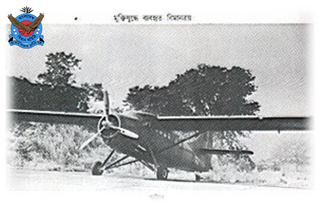
Kilo Flight was the code name for the Mukti Bahini combat aviation formation during the Bangladesh Liberation War in 1971. It consisted of one DHC-3 Otter plane and one Alouette III helicopter, both carrying rocket pods and machine guns for launching hit-and-run attacks on Pakistani targets, and one DC-3 Dakota for logistical missions. 9 Bengali pilots and 58 ex PAF personnel formed the unit under the command of Group Captain A. K. Khandker in September 1971. The aircraft were supplied by Indian Authorities and the formation was led by Squadron Leader Sultan Mahmud under the operational control of IAF base Jorhat. The unit started training in October 1971 at Dimapur in Nagaland, and this unit was the first to launch airstrikes on Pakistani targets in East Pakistan on December 4, 1971, by attacking oil depots at Narayanganj and Chittagong. In total the unit flew 90 sorties and 40 combat missions between December 4 and 16, 1971. After the war, this unit formed the core of the nascent Bangladesh Air Force.
The No. 15 Squadron, nicknamed Cobras, is a tactical attack squadron of the Pakistan Air Force (PAF). The Squadron is currently based at PAF Base Minhas in Kamra, Punjab, Pakistan and equipped with Chengdu J-10C multirole fighter jets. The Squadron also carries the honour of achieving the first kill for the PAF.











